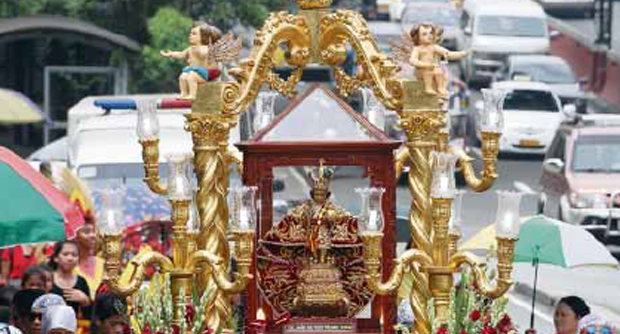
THE REPLICA of the Sto.Niño de Cebu jostles for road space in Manila’s traffic on the way to San Agustin Church in Intramuros
Sunday for a Mass. NIÑO JESUS ORBETA
MANILA, Philippines—The quiet walled city of Intramuros on Sunday burst in joy, pounding drums, street dancing and a shower of glittering confetti as the pilgrim image of the Sto. Niño arrived from Cebu.
Chanting “Viva Sto. Niño!” and waving little red and yellow flags, hundreds of devotees of the Child Jesus braved the scorching heat to join the procession that started with a symbolic turnover on busy Quezon Bridge in Quiapo, Manila, and culminated in a Mass at San Agustin Church inside the walled city.
Among the devotees was 66-year-old Diosdada Panoy, who has been a believer since she was a child in her native Dipolog City.
Panoy said she wanted to see the image of the Child Jesus in thanksgiving for the healing of her asthma, which had plagued her for years.
“I used to take medicines for my asthma but not after I was healed because of the Sto. Niño,” said Panoy, of the Baseco compound in Tondo, Manila.
Panoy came with her neighbor, Janilyn Rabara, who developed a deep devotion to the Sto. Niño as a child, after participating in the Ati-Atihan festivals in Aklan. “I had been joining the street dancing back home since I was 7,” she told the Inquirer.
The image, a replica of the centuries-old Sto. Niño enthroned in the Basilica Minore del Santo Niño de Cebu, will remain at San Agustin Church until May 31. It will also be brought to Marikina and Quezon City from May 26 to 28, according to Fr. Michael Go, coordinator of the San Agustin visit.
Bringing the icon to the capital is part of the yearlong celebration of the 450th anniversary of its historic finding in Cebu and the 450 years in the Philippines of the Augustinians, who propagated among Filipinos a deep devotion to the Child Jesus.
The image of the Holy Child was found following the arrival of five Spanish missionaries led by Fray Andres de Urdaneta and the Spanish colonizers headed by Miguel Lopez de Legazpi in Cebu on April 28, 1565.
The image of the Sto. Niño, touted as the oldest religious relic in the Philippines, was spotted by Spanish soldier Juan Camus in one of the burned houses, untouched by the fire that ravaged a village during a conflict between Spanish soldiers and natives.
On the spot where the image was found now stands the Basilica Minore del Santo Niño de Cebu, home of the icon for centuries. The church was originally made of bower branches, with a covering of hay.


